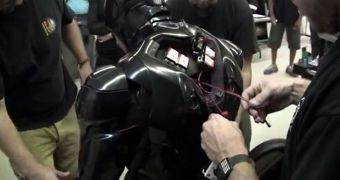Being a prop artist is all well and good, but there are some things that even the best can't pull off, even if they get the most thorough measurements possible from the actors they need to make equipment for.
Fortunately, 3D printing technology has begun to help them out, allowing for a new generation of props, especially things that need to be worn.
One of the most important examples of the past few years is the robotic suit used in the Robocop reboot launched earlier this year.
Those who watched the film will remember it for its tight-fitting, sleek, black armor, even though the suit was set aside at the end of the movie in favor of the metallic grey version.
To make the suit, Legacy Effects called on the talents of 3D model maker Martin Whist, who created the 3D schematic for it.
Different 3D printers were used to make different parts of the suit. There were quite a few segments too, because it had to be flexible.
Robocop performs quite a few stunts in the film after all, and it's not exactly easy to ride a motorbike if you can stretch your legs properly or bend your knees at a correct angle.
Also, in addition to the body and face of actor Joel Kinnaman, the prop makers had to accommodate magnets, batteries and LED lights, the things needed for the special effects.
What's more, they had to make more than one suit, since the thing gets totaled more than once over the course of the film.
Sure, there were some things that couldn't be 3D printed, which artists had to apply, such as some of the intricate details and patterns. More importantly, the suit was outfitted with a cooling vest not unlike those worn by racecar drivers (those, obviously, can't be 3D printed, at least not with current technology).
Still, most of it was, like the legacy suit for that matter (the grey one), even if it was just a homage to the original film and wasn't on screen for more than 2 or 3 scenes.
Furthermore, the EM208 and EB207 robot statues (part of the backgrounds of some scenes) were 3D printed too.
The efforts of everyone involved in the production process yielded good results, ensuring a tight but comfortable fit for the body armor. Several different materials were used, mostly variations of plastic. Legacy Effect has posted a video on YouTube where it chronicles the procedure. You can watch it below.

 14 DAY TRIAL //
14 DAY TRIAL // 